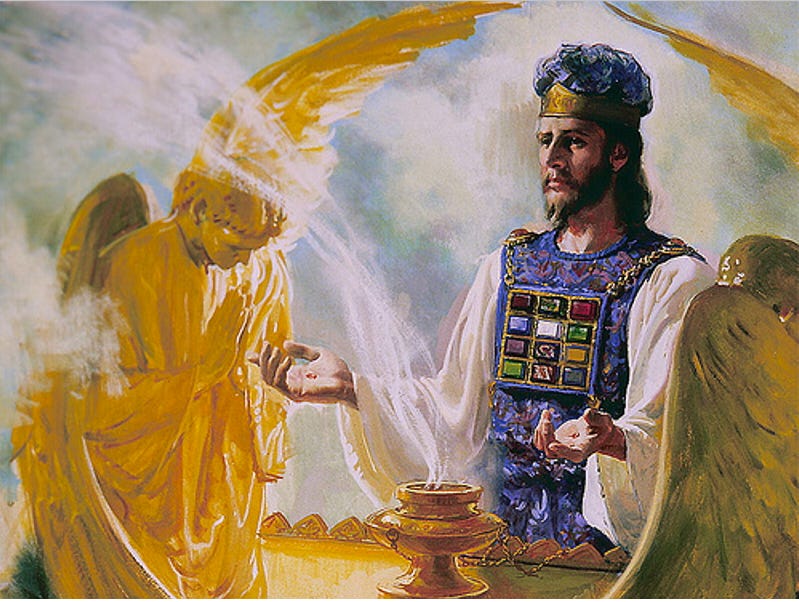Julius Evola's Revolt, Part 3: He Who Sits on the Axis of the World
IT should now be clear that behind Evolian thinking lies an important distinction between two opposed forces and by placing the king, or pontifex, at the centre of human affairs the world of Tradition is grounded upon a motionless axis that Evola describes as "spiritual stability".
This sacred centre is both epitomised and reinforced by the visual trappings of kingship that are designed to faithfully convey the mystical significance of the monarch's role at the meeting of the two worlds:
One of these symbols was the sceptre, the main function of which is analogically related to the “axis of the world.” Another symbol is the throne, an “elevated” place; sitting still on the throne evokes, in addition to the meaning of stability connected to the “pole” and to the “unmoved mover,” the corresponding inner and metaphysical meanings. Considering the correspondence that was originally believed to exist between the nature of the royal man and the nature produced by initiation, in the classical Mysteries we find a ritual consisting of sitting still on a throne. [p.17.]
The king himself, dressed in the accompanying regalia of his semi-divine office, is a living embodiment of the consecrated initiate and on reaching the centre the monarch becomes an unimpeachable figurehead of strength and justice. Evola compares this unique orientation to the way in which the kings of the Ancient Egyptians were said to sustain themselves with "an inner state of being and an energy".
Whilst this reliable, stationery hub bears a true sense of peace and serenity - lying, as it does, at the very centre of the universe - Evola warns his readers that
this is not the profane and social peace pursued by a political government—a kind of peace that is at most an external consequence—but rather an inner and positive peace, which should not be divorced from the “triumphal” element. This peace does not convey the notion of cessation, but rather that of the highest degree of perfection of a pure, inner and withdrawn activity. It is a calm that reveals the supernatural. [p.18.]
In other words, far from being a passive stalk in the midst of a furious gale, the pontifex commands the type of symbolic presence that terrifies his enemies without even having to raise a finger, let alone a sword. It is this which grants the king such a peculiarly individual supremacy over his fellows:
Conversely, the ethos of superiority over the world, of dominating calm and of imperturbability combined with readiness for absolute command, which has remained the characteristic of various aristocratic types even after the secularization of nobility, must be considered an echo of that element that was originally the regal, spiritual, and transcendent element. [p.19.]
Furthermore, the regent fulfils his duties in the way that a Hindu ruler was perceived as the cakravarin, or "universal king," and Evola believed that such an interpretation was alive and well in Europe until the Hohenstaufen dynasty that ruled the Holy Roman Empire between 1138 and 1254. Long before the arrival of the Middle Ages, of course, there were countless examples of rulers said to combine the attributes of peace and justice and the author singles out the Salem monarch, Melchizedek, for special attention:
Guénon has pointed out that in Hebrew, mekki-tsedeq means “king of justice,” while Salem, of which he is king, is not a city, but rather “peace,” at least according to Paul’s exegesis. Tradition upholds the superiority of Melchizedek’s royal priesthood over Abraham’s. It is not without a deep reason that Melchizedek was present in the enigmatic medieval allegory of the “three rings,” and that he declared that neither Christianity nor Islam know any longer which is the true religion; moreover, the “royal religion of Melchizedek” was often upheld by the Ghibelline ideology in the struggle against the Church. [p.19.]
Whilst we shall be discussing the Ghibellines later on, Melchizedek is important here as a result of his Hebrew appellation perfectly expressing the divine righteousness of all such kings and Evola's point about the superiority of his particular priesthood is a reference to the supremacy of the Zadokite priests over their Levite counterparts. Melchizedek was not simply part of a religious order, therefore, but also connected to a royal line. As Evola explains in relation to the Platonic view of the state, a far older example and one which also included Traditionalist features:
In Plato the idea of justice (δικαιοσὐνη), of which the state should be the embodiment, is closely related to that of οἱκειοπραγία or cuique suum. that is, with the principle according to which everybody should fulfill the function typical of his or her own nature. Thus the “king of justice” is also the primordial legislator, or he who instituted the castes, assigned the offices, and established the rites; or, in other words, he who determined the ethical and sacred system that was called dharmanga in Aryan India, and that in other traditions was the local ritual system that determined the norms for regulating individual and collective life. [p.20.]
Given the characteristic empty-headedness of today's European monarchs, to whom all such knowledge is either anathema or completely beyond their capabilities, the philosopher-kings of the past were truly superior in both thought and deed.




